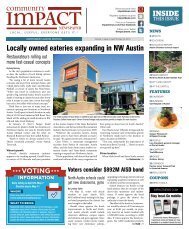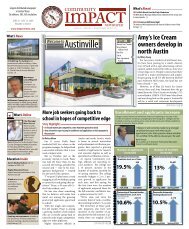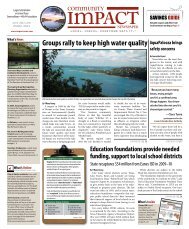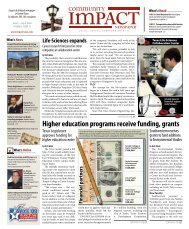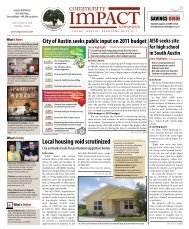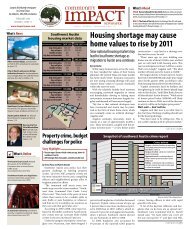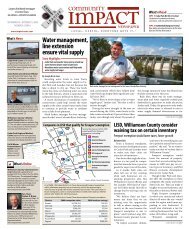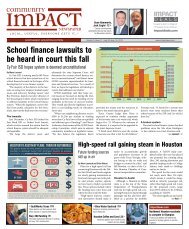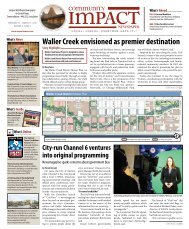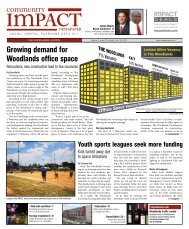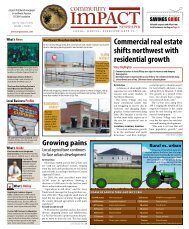Austin - Community Impact Newspaper
Austin - Community Impact Newspaper
Austin - Community Impact Newspaper
Create successful ePaper yourself
Turn your PDF publications into a flip-book with our unique Google optimized e-Paper software.
Nonattainment<br />
CONTINUED FROM |1<br />
Environmental Quality would develop a<br />
plan for the region to regain compliance.<br />
The plan, inspired by the principle, “First<br />
do no harm,” would guide major decisions<br />
on transportation and business.<br />
All transportation projects would have<br />
to conform with the plan, with the penalty<br />
of failure being the withholding of federal<br />
transportation funds. Additionally,<br />
general conformity guidelines can place<br />
restrictions on business operations, local<br />
companies wishing to expand and businesses<br />
wanting to relocate to <strong>Austin</strong>.<br />
<strong>Austin</strong> Mayor Lee Leffingwell said once<br />
a county is classified nonattainment, it will<br />
undergo changes with lasting implications.<br />
“You are going to begin to lose federal<br />
funds, for a lot of purposes, including new<br />
highway construction. You’re going to begin<br />
to require new rules and regulations,”<br />
he said. “For example, automobile emissions<br />
testing is going to be a requirement.”<br />
Leffingwell also said the federal government<br />
will impose new rules that have<br />
the purpose of, at some point, directing<br />
counties back toward attainment status.<br />
Regulations would apply for 20 years<br />
after <strong>Austin</strong> returns to compliance. Nonattainment<br />
status could also adversely<br />
affect people’s perception of <strong>Austin</strong> as<br />
an environmentally friendly place to live<br />
and visit.<br />
“If you’re designated nonattainment, it<br />
singles you out as a dirty air area, even<br />
though we’re not dirty compared to<br />
Houston or Dallas,” Gill said.<br />
On high-ozone days, about 60 to 80 percent<br />
of <strong>Austin</strong>’s ozone is carried here by<br />
wind from places like Houston and East<br />
Texas, he said. Locally generated ozone<br />
“Once you’re designated<br />
nonattainment, it takes<br />
a long time to get rid of<br />
that designation. There<br />
are going to be all kinds<br />
of new rules imposed by<br />
the federal government<br />
that have the purpose of,<br />
at some point, directing<br />
you back toward<br />
attainment status.”<br />
Mayor Lee Leffingwell, City of <strong>Austin</strong><br />
comes from many sources, including<br />
homes, businesses, construction and cars.<br />
Based on preliminary research, Gov. Rick<br />
Perry recommended to the Environmental<br />
Protection Agency that Travis County<br />
be designated nonattainment. After six<br />
months of monitoring the area’s air quality,<br />
the EPA will announce its initial decision in<br />
November. The public will have 30 days to<br />
comment, starting Nov. 12. EPA will make<br />
its final decision March 12, 2010.<br />
Ozone<br />
Ozone is formed naturally high in the<br />
stratosphere when the sun’s ultraviolet rays<br />
interact with oxygen molecules. Groundlevel<br />
ozone, which is harmful to humans’<br />
health, is formed when nitrogen oxides<br />
(NOx) and volatile organic compounds<br />
(VOC) combine in the presence of sunlight.<br />
Car exhaust, industrial emissions, gasoline<br />
vapors and chemical solvents are<br />
manmade sources of NOx and VOC. Due<br />
to the summer sun, ozone is typically most<br />
prevalent from April through October.<br />
Capital Area ozone — a high concentration<br />
of ground-level ozone, caused by<br />
humans — is a health hazard. It is different<br />
from naturally occurring ozone,<br />
which is high in the stratosphere.<br />
The prevailing downturn in the economy<br />
may help <strong>Austin</strong> achieve compliance.<br />
Fewer cars on the road, less buildings<br />
under construction and reduced commercial<br />
activity have cut major sources<br />
of air pollution.<br />
“The recession may help this season,<br />
which is sad to say,” Stephens said.<br />
Comment at more.impactnews.com/4284<br />
impactnews.com July 2009 | 27<br />
Early enrollment pricing ends soon!<br />
Prime Exhibitor Spaces and Sponsorships still available<br />
Building Financially Literate Communities<br />
Helping you earn, save, invest<br />
and spend more wisely. Hosted by:<br />
®<br />
Clean air TIPS<br />
In the CAR<br />
• Share a ride to work or school<br />
• Avoid rush-hour traffic and driving on<br />
hot days<br />
• Take your lunch to work or school<br />
• Use public transit, walk or ride a bicycle<br />
• Combine errands into one trip<br />
• Avoid drive-thru lanes<br />
• Postpone refueling until after 6 p.m.<br />
• Do not top off your tank while refueling<br />
• Keep vehicles tuned and tires properly<br />
inflated<br />
• Do not ignore “check engine” lights<br />
• Avoid revving or idling engine more than<br />
30 seconds<br />
In the yARD<br />
Keeping watch on the OZONE<br />
MONITORING<br />
During ozone season, April 1 to Oct. 31,<br />
the Texas Commission on Environmental<br />
Quality operates two ozone regulatory<br />
monitors located in <strong>Austin</strong>, one of which<br />
is at Murchison Middle School, at 3724 N.<br />
Hills Drive. These monitors collect data on<br />
ground-level ozone concentrations; ozone<br />
precursor concentrations such as nitrogen<br />
oxides, sulfur dioxide, carbon monoxide and<br />
meteorological data.<br />
For more information, visit www.tceq.<br />
state.tx.us/cgi-bin/compliance/monops/<br />
site_photo.pl?cams=3.<br />
Source: Texas Commission on Environmental Quality<br />
• Avoid spilling gasoline<br />
• Maintain equipment<br />
• Consider cleaner options, like newer or<br />
electric equipment<br />
• Wait until after 6 p.m. to do yard work<br />
with gas equipment<br />
• Use manual tools<br />
• Reduce mowing time by planting lowmaintenance<br />
grasses<br />
• Recycle old equipment<br />
CAMS 690 Lake Georgetown<br />
N<br />
CAMS 38 Audubon<br />
Hays<br />
Travis<br />
Williamson<br />
CAMS 614 Dripping Springs<br />
CAMS 675 San Marcos<br />
<strong>Austin</strong>-Round Rock MSA<br />
TCEQ Regulatory Monitors<br />
CAPCOG Monitors<br />
In the HOUSE<br />
• Use compact fluorescent lights<br />
• Turn off lights and appliances when not<br />
in use<br />
• Use microwaves for smaller meals<br />
• Recycle<br />
• Plant trees for shade to reduce<br />
dependence on air conditioning<br />
• Reuse materials such as paper bags and<br />
boxes<br />
• Properly dispose of household hazardous<br />
waste<br />
• Paint with brushes, not sprayers<br />
• Check air-conditioning filters monthly<br />
On the WEB<br />
Learn about Energy Star products, certified<br />
for energy efficiency, www.energystar.gov<br />
Find out how “green” your car is with the<br />
Vehicle Emissions Guide, www.epa.gov/<br />
autoemissions<br />
Find information on disposing of toxic<br />
solid waste, www.epa.gov/epaoswer/osw/<br />
citizens.htm<br />
Keep track of the Clean Air Coalition,<br />
www.capcog.org/divisions/<br />
regional-planning/clean-air-coalition<br />
Sources: Texas Commission on Environmental Quality and Environmental Protection Agency<br />
CAMS 674 Round Rock<br />
CAMS 03 Austn NW Murchison<br />
Caldwell<br />
CAMS 684 McKinney Roughs<br />
Bastrop<br />
<strong>Austin</strong> Northwest Murchison monitor at 3724 N. Hills Drive<br />
N. Hills Dr.<br />
Hart Ln.<br />
Far W. Blvd.<br />
September 25 & 26, 2009<br />
<strong>Austin</strong> Convention Center<br />
For more information, contact<br />
Craig Moritz • 713-464-4459<br />
austinmoneyshow.com<br />
N<br />
MoPac



